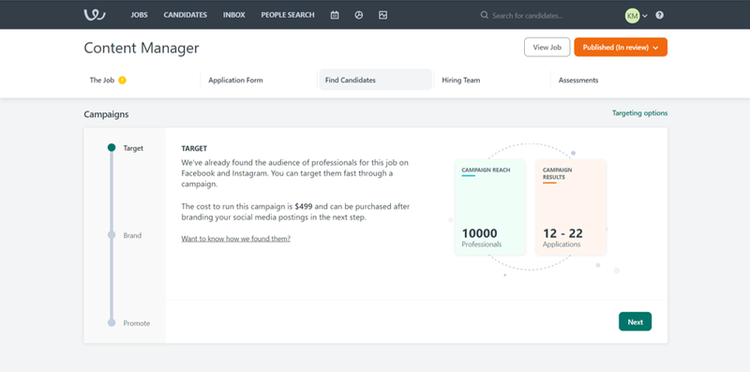In chess, it’s not enough to be thinking of your next move; your brain needs to be thinking about several moves in the future. The same is true of recruitment.
As a recruiter, you always need to be thinking about several recruitment stages in the future. Don’t just be thinking about opening a job position, but consider where you’ll find candidates and what criteria you’ll use to screen them.
This is where pipeline recruiting comes in.
Overview: What is a recruitment pipeline?
A recruitment pipeline is similar to a sales pipeline. Think about the different stages of your recruitment process, whether that’s sourcing, screening, skills testing, interviewing, onboarding, or something else entirely.
It might look something like the below.

A recruitment pipeline represents the different stages of the hiring process. Image source: Author
Source: Workable software.
You feed candidates into the pipeline -- or they feed themselves in, depending on the recruitment software you have in place. The ideal is to have candidates spread across the different areas of the pipeline and to know exactly how many candidates are in each stage and how long they have been in that stage.
You should have different candidate pipelines for each open position. Some recruiters will even have general pipelines with candidates that are a good fit for the company, but for whom there isn’t necessarily an open position at the moment.
3 benefits of pipeline recruiting
Pipeline hiring will help you move from a reactive recruiter to a proactive recruiter, saving you time and money, and giving you access to the most talented candidates. Here are the benefits of creating a recruitment pipeline.
1. Provides a steady supply of candidates
You might think that when you start screening or interviewing candidates you can stop sourcing. One of these candidates will be suitable, right? Not necessarily.
You shouldn’t stop sourcing candidates or take down your job ad until the potential new hire has signed a contract. If you stop before that, then it’ll slow down the hiring process considerably, as you’ll have to start from scratch if one of the candidates drops out.
2. Easier to track what’s working
When you create different areas of the pipeline for different candidates, you can work out which recruitment stages are slowing down the process and need attention.
If you have 10 candidates all in the interview stage, then you need to find out why. Was it just a one-off event, such as a vacation for the hiring manager? Or does the team manager keep rescheduling interviews because they don’t have time?
Once you understand the blockers, you can take steps to resolve the issue and speed up the recruitment process.
3. Increases the quality of your candidates
Ensuring you implement and optimize the recruiting pipeline stages for attracting candidates can help improve the quality of your applicants. If you invest in a careers portal and recruitment marketing strategies, such as social media posts and ads, you can passively attract candidates who resonate with your brand.
If you have set up these stages properly, then you can improve the candidate experience by ensuring all applicants move swiftly through the process rather than being left in limbo.
Delivering a top-quality candidate experience also means better employee satisfaction and more chance of the new hires referring their equally talented friends and former coworkers.
How to create a recruitment pipeline
Here are five steps you should take to create a recruitment pipeline, get enough candidates in each stage, and ensure they flow seamlessly from one stage to the next.
1. Embrace employer branding
The talent pipeline starts before you even advertise a job opening. To ensure you have candidates in the pre-sourcing stage, you need to showcase your business as a great place to work. Be clear on who you are, what your mission is, what your values are, and how you operate.
If you do that, candidates will be ready to apply for open positions the minute you put the ad out, and you get speculative resumes from talented candidates. You’re also more likely to attract people who fit with your company culture and believe in what you do. In turn, this will increase employee satisfaction and decrease turnover.
2. Create a process for sourcing passive candidates
The best candidates might be the ones who aren’t looking for a job right now. If you want to ensure you have the best applicants in the sourcing stage of your pipeline, you need to understand how to find passive candidates.
This will vary according to your industry and recruitment process, but social media is a good place to start. You can also use the search functionality within your applicant tracking system (ATS).
Workable has an artificial intelligence-powered Auto-Suggest feature that searches public online profiles to find candidates who match the skills and requirements you have specified in your job description.
It then helps you create effective, targeted campaigns on channels such as Facebook to make these people aware of the job and encourage them to apply.

Workable’s Auto-Suggest feature helps you find passive candidates. Image source: Author
Source: Workable.
3. Invest in recruitment marketing
Once you advertise a position, you need to make sure that the right people see the job ad. Think about this in the same way you market your product or service and get advice from the marketing department.
Track and measure the channels you use to market and advertise the job ads to see which yield the best results. Find out where your ideal candidates hang out (online and offline), so you know where you need to invest your time and money to get the best candidates into the hiring pipeline.
Some channels you might want to consider include:
- Paid advertising on social media
- Email newsletters
- Your careers portal
- Third-party jobs boards, such as Monster, Indeed, and LinkedIn
4. Automate the screening process
Some job positions attract a lot of candidates, but how many of those are qualified applicants that you’ll want to move through to the next round?
Sifting through mountains of resumes to find the right candidates slows down the recruitment process and increases the chance that talented candidates will slip through the cracks. That’s why you need an ATS to automate the process.
You can use your ATS to disqualify (or qualify) candidates according to keywords or certain other attributes and create a scorecard from those factors. Then you can move the best candidates through to the next stage and keep the pipeline flowing.

Breezy HR helps you build a scorecard to evaluate candidates. Image source: Author
Breezy HR helps you create a scorecard that lets you easily evaluate candidates based on whether they meet the predefined criteria for this position. When you’ve filled out the scorecard, you will get a score that shows how suitable the candidate is for the position.
5. Measure and track the performance of each stage
The pipeline isn’t rigid. You may find you need to add and remove stages depending on the job position, your custom recruitment process, and your company’s needs. You should also track how much time candidates spend in each pipeline stage so you can spot problems or decide if stages need to be broken up to make them more manageable.
Get your strategy in order first
Remember that your recruitment pipeline is only as good as the tools you use and the strategy you employ. If you don't have the right software to manage the process, candidates can end up stuck in the system for weeks, or you might completely miss talented applicants. Get your hiring strategy and process sorted before moving on to more advanced recruiting practices.
Our Small Business Expert
We're firm believers in the Golden Rule, which is why editorial opinions are ours alone and have not been previously reviewed, approved, or endorsed by included advertisers. The Ascent does not cover all offers on the market. Editorial content from The Ascent is separate from The Motley Fool editorial content and is created by a different analyst team.